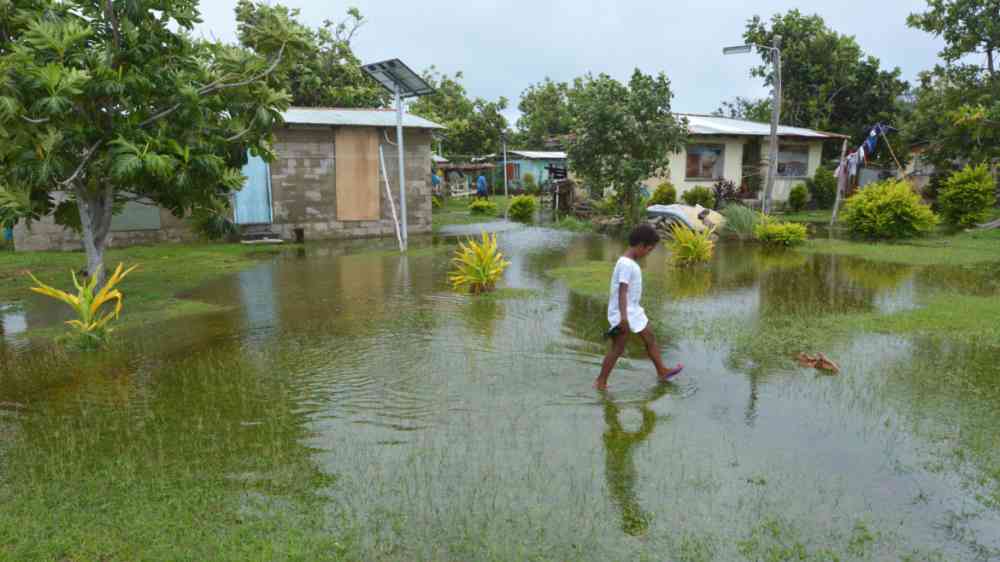Pathways towards a Pacific-owned anticipatory action model

Anticipatory action is gaining increasing attention as an effective mechanism for mitigating the impacts of crises on populations before they occur. In the Pacific region, there is an ongoing dialogue about how such systems can be implemented. This is one of the regions most at risk from disasters globally, but anticipatory action systems have yet to be established at the national or regional levels.
The Humanitarian Advisory Group, the Pacific Islands Association of Non-Governmental Organisations and the Food and Agricultural Organization of the United Nations have recently undertaken research exploring pathways and best-practice approaches to establishing anticipatory action mechanisms in the Pacific. This research makes the case for mechanisms that support the region’s existing resilience architecture, and which are owned and facilitated by Pacific governments in ways that best uphold the values and priorities of the region and its communities.
The recent report On the Front Foot: Envisioning a Model for Anticipatory Action in the Pacific explores the entry points for anticipatory action within the region and identifies the potential barriers facing practitioners tasked with its implementation.
Entry points
While anticipatory action systems in the Pacific region have yet to be established, elements exist at the community level. These are often demonstrated in processes where traditional knowledge is used in early warning systems.
Furthermore, the Pacific is home to an extensive resilience architecture that could be a solid foundation for anticipatory action processes to build upon. Regional frameworks, such as the 2050 Strategy for a Blue Pacific Continent and the Framework for Resilient Development in the Pacific, could help guide coordination in line with the region’s resilience priorities, while the Pacific Resilience Partnership could provide an effective platform for multistakeholder coordination.
The Pacific region is also home to a network of strong regional actors, such as the Council of Regional Organisations in the Pacific agencies and an extensive civil society network; these could help to build locally led anticipatory action mechanisms from the ground up. Stakeholders in the region have urged for anticipatory action mechanisms to build upon this existing architecture and avoid creating new systems and processes.
Pacific government actor
Challenges
Despite these entry points, implementing anticipatory action in the Pacific faces a number of key challenges for practitioners to address. For example, global terminology associated with anticipatory action, early warning systems and other resilience-based practice is unlikely to be familiar across Pacific communities; this was raised at the Pacific Week of Anticipatory Action workshop in Nadi, Fiji, in March 2023.
Anticipatory action relies on data availability and sharing, which has long been an issue in the region due to limited governmental coordination. Additionally, the capacity of the national services needed for anticipatory action is limited, and likely to be stretched when facilitating large-scale anticipatory action systems. These include banking systems, social protection systems and meteorological agencies.
The geography of the region presents further challenges: scattered small islands make it challenging to predict whether a tropical cyclone will hit the populated islands, while many communities live in remote locations and hard-to-reach outer islands, where it is difficult to deliver timely assistance. Compounding this is the limited digital literacy, social protection systems and banking infrastructure in many remote communities.
It is important for practitioners to consider how anticipatory action systems can support and strengthen these systems, rather than further stretching their capacities and causing unfavourable outcomes. Anticipatory action should also build resilience within communities, for example by focusing on cash and non-cash approaches, as well as empowering communities to lead and make decisions on their needs in anticipatory action processes.
International actor
The pathway forward
The way forward for implementing anticipatory action in the Pacific region – developed in partnership with regional stakeholders – should start where anticipatory action elements are already at play: the community level. There is an opportunity to build upon the existing elements that underpin resilience processes at the community level, exploring how these can be scaled upwards and linked to national disaster-risk-financing systems in ways that preserve and elevate traditional knowledge and practice. Processes can be facilitated by civil society networks across the region; for example, the Facility Aiding Locally Led Engagement Pasifika can mobilize local actors to carry out timely support to at-risk and remote communities.
Pacific regional actor
Donors and regional bodies can support Pacific governments to strengthen local and national capacities, such as social protection systems, banking systems, vulnerability assessments and data sharing, through enhanced ministerial coordination. This can in turn support the process of building anticipatory action mechanisms at the national level.
Following this, there is an opportunity to establish guiding principles, standards and criteria at the regional level, which can align to the regional priorities of the Framework for Resilient Development in the Pacific. These may be supported by a technical working group for the region, facilitated through the Pacific Resilience Partnership, that brings civil society and community leaders together with governments to inform decision-making processes. Finally, the key message from the research is the need to avoid externally driven approaches.
While examples from global evidence on anticipatory action can inform the development of mechanisms in the region, it is imperative for anticipatory action to be implemented and facilitated by Pacific actors. Doing so can help to ensure that anticipatory action aligns with and strengthens the existing architecture within the region, and supports the priorities of communities, Pacific governments and the agencies in the Council of Regional Organisations in the Pacific.